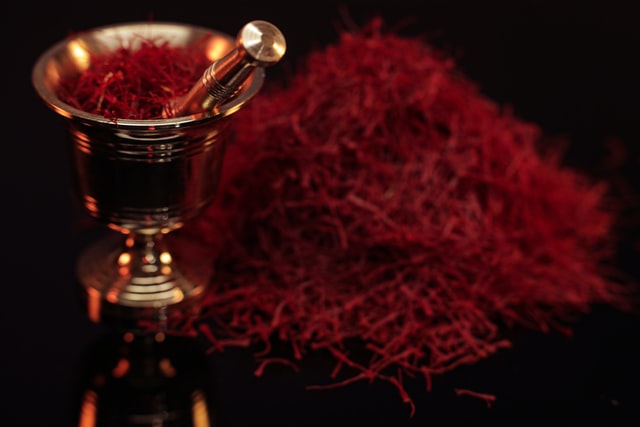
Flower Power: 10 minutes with Saffron
As far back as the first century A.D. in the Roman Empire, Pliny expressed concern that Saffron was the most falsified commodity at the marketplace. Due to its high cost derived from pain-staking and laborious cultivation, it was being adulterated in many different, cheaper forms; from shards of dyed colored wax, to dried meat strands, dried marigold flowers and even dried willow roots! Oh, the Tomfoolery!!! Did you know that saffron was even mentioned in the Bible? (Soloman 4:13-14). But why? What makes this particular so special?
For starters, saffron is the dried stigma of the saffron crocus flower (crocus sativus), which is part of the lily family. There are only 3 stigmas per flower and they have to be picked by hand. 1 acre of planted saffron crocus flowers produces an average of 10 pounds of saffron. There are roughly 70,000 saffron crocus flowers producing 210,000 stigmas in one pound. Oh, and then it has to be dried - drying removes 80% of its total weight, so actually, every five pounds of fresh stigmas only produces 1 pound of dried saffron. But that's not all... Even thought the saffron crocus is a perennial, it reaches its maximum potential at year 3, so most saffron crocus farmers find themselves replacing the plants every three or 4 years (up to 10-15 years for kashmiri saffron (India)). Oh and did I mention that most crocus flowers are extremely toxic to humans? Unfortunately you can't just go out picking the stigmas out of any crocus flower - only the ones from the saffron crocus, (crocus sativus) will work.
Now let's take a quick look at saffron throughout history. As its origins can be traced back to Asia Minor, most of the eastern Mediterranean, Egypt, and the Romans were using saffron for everything from perfumes, to dye, to food and beverages. All the way back to Greco-Roman times, saffron was used as a deodorizer in public places, such as walkways and theaters. The Roman emperor Heliogabalus (AD 218-222) was said to have soaked in baths rich with steeped saffron. And then in 711, the Moors crossed the Strait of Gibraltar and invaded and conquered Spain; then around 960 AD, saffron production started popping up in some regions of Spain. It is thought that the spread of saffron throughout Middle-Aged Europe was due largely in-part to the Crusaders returning from fighting in the holy land that brought back the saffron crocus flowers with them. The popularity of saffron spread across Europe like wild fire and in Nurnburg, Germany in 1358, the first saffron inspection committee was formed and mandated that all peddlers of saffron must provide a sample for scrutinous inspection. These people took their jobs very seriously, because in 1444 and 1456 two different merchants were found to be selling adulterated saffron; one was burned alive with his false wares and the other was buried alive, with his Gucci knock-off saffron. The Gestapo-esque committee eventually lessened the punishment to stiff fines, but they were still around until 1797. Next door over in France in 1550, King Henry II decreed that anyone found guilty of trying to achieve monetary gain from selling adulterated saffron would receive "corrective corporal punishment". YIKES!
Not only has saffron been highly regarded for it's culinary benefits, but it is also prized for its coloring properties. This colorant has been used in many forms by various cultures to promote hospitality and even wealth. Saffron was also thought to have excellent healing properties. Hippocrates said that it cured indigestion and tooth aches. In 16th century England, if you were in a good mood, you were said to have slept in a bag of saffron. People would drink saffron tea as it was thought to promote optimism, and Irish women would even sleep with it in the bed sheets as they thought it strengthened bones. And saffron is what colors the fined flavored French liqueur, Chartreuse, btw.
I said 10 minutes so I'm going to wrap this up, but I do promise a second part to this interview with saffron because I want to further break saffron down by where it is grown and produced in our current day. The best saffron is still said to come from Spain, but there are some other countries that grown saffron, all with their own individual appearance and flavor profile. And then there's fake saffron. I'm not lying to you, there's even a super extra duper fake, cheap cheap cheap saffron available right now that is made from a flavored, dyed, dissolvable plastic (click here to go to a page that has a picture of this nightmare stuff!!!). So, when buying saffron, look for a deep, dark red color with lots of fragrance. Be weary of lighter red colored saffrons, and stay the heck away from yellow saffron or safflower! Safflower, or alazor, or carthamus tinctorius, is a fake saffron imposter that will sometimes be labeled as saffron, but it's not - it's safflower. And safflower only colors, not flavors!
But, before I go, I have to say that there are a few iconic dishes that would not be who they are without the use of saffron. Bouillabaise... Paella... Classics are classics for a reason! I have included some of my favorite saffron recipes with this post, so I hope you enjoy them! Also, pro-tip, throw some saffron into your next lemon bars or lemon squares recipe... you'll thank me later! Oh, and one more thing now that i'm thinking about it... Sometimes saffron can take a little while to release all of its color (up to an hour). Next time you are using it in a recipe with some soft of liquid, like stock or white wine, "bloom" the saffron by letting it soak/steep in the stock or wine for 20-30 minutes so it can begin to start leaching out its beautiful color. Otherwise you're final dish will have red spots.. we've all seen them. And lastly, NO. THE ANSWER IS NO! COMBINING 1 PART PAPRIKA AND 1 PART TURMERIC DOES NOT
MAKE SAFFRON! It's apparently a thing, but no, you cannot "make" your own saffron!
Here are my favorite recipes with saffron. Give them a click to see the full recipes!
